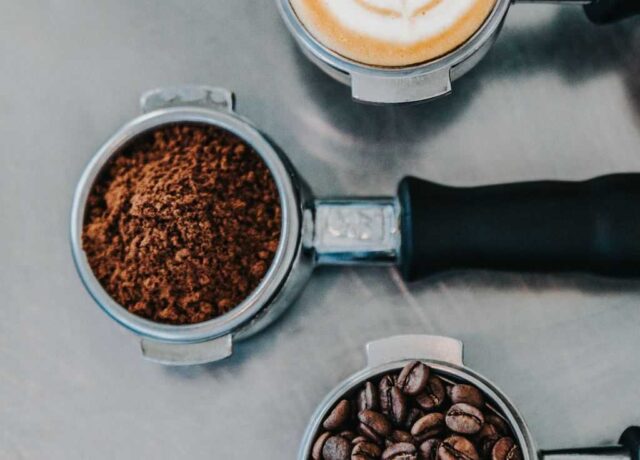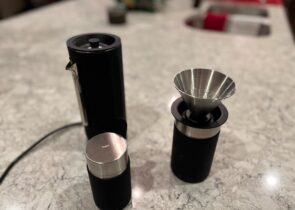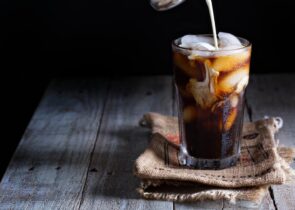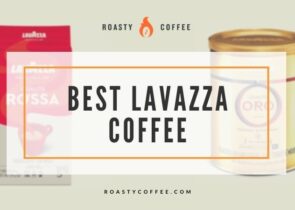A fresh and aromatic cup of coffee can make a coffee connoisseur’s morning far more flavorful, but store-bought brands can become boring. For this reason, many coffee lovers are trying international blends such as authentic Vietnamese coffee.
Vietnamese coffee is quickly becoming a global favorite due to its complex flavors and distinct brewing method. Let’s explore some of the best Vietnamese coffee brands to discover what all the hype is about!
At a Glance: Best Vietnamese Coffee
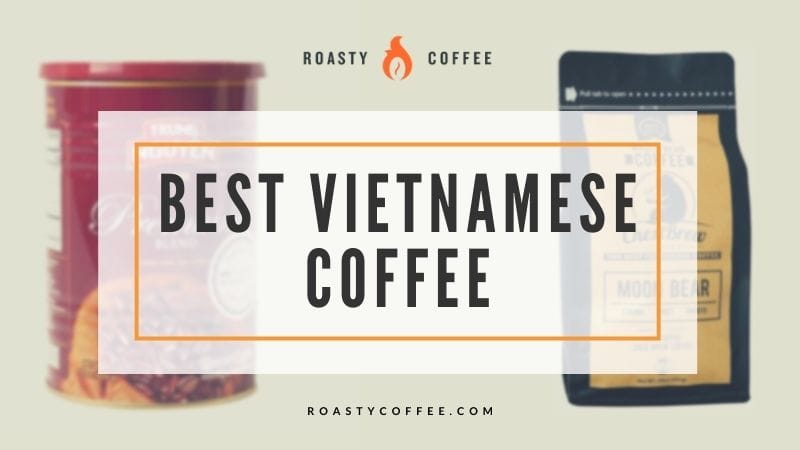
Top 5 Vietnamese Coffee Blends
Quick Summary: Best Vietnamese Coffee
 | Our Top Pick Trung Nguyen Premium Blend |
| Check on Amazon → |
 | Robarica Dark Roast |
| Check on Amazon → |
 | ChestBrew Moon Bear |
| Check on Amazon → |
 | Lang Thang Coffee Saigon Phin Daklak |
| Check on Amazon → |
 | Strong AF Coffee Rude Awakening |
| Check on Amazon → |
If you’re curious about Vietnamese coffee and the different blends available, I’ve laid it all out for you below. Here are my top 5 picks and some pros and cons for each.
Trung Nguyen Premium Blend
Trung Nguyen Coffee Supply is one of the most popular and accessible brands of Vietnamese coffee in Southeast Asia. One of their most flavorful selections is the Trung Nguyen Premium Blend coffee.
This signature blend is a combination of arabica and robusta coffee beans complemented by a rich chocolatey taste that gives a sweet start to anyone’s day.
Each 15-ounce can contain about 21 servings, ensuring that you can enjoy several weeks of flavorful coffee before needing to place another order. Thanks to the tight-fitting plastic lid, it’s easy to keep these grounds fresh.
Though this coffee bean blend isn’t as highly caffeinated as other options, the cup I brewed had a velvety smooth consistency that pairs well with a bit of condensed milk or creamer.
Unlike other types of coffee, this brew had a relatively low acidity level that didn’t cause any digestive issues for me.
Pros
- The coffee can keep the grounds fresher longer than standard bags.
- It has a delicate consistency that pairs perfectly with creamer or milk.
- The hint of chocolate adds a rich complexity that lingers after each sip.
- This option is budget-friendly and is available from multiple retailers.
Cons
- The coffee has a comparatively low caffeine content.
- This coffee contains artificial flavors.
Robarica Dark Roast
Those looking for authentic, all-natural Vietnamese brew might fall head over heels for Robarica Dark Roast. I certainly did!
Each 2.2-pound bag is packed full of fine coffee grounds that fit neatly into a phin filter (a Vietnamese coffee maker) or espresso maker. While this fine consistency might be a drawback for most coffees, it’s an advantage for Robarica Dark Roast.
That’s because it is a high-caffeine alternative to Vietnamese medium roast coffees and appeals to coffee lovers looking for that caffeine fix.
Though the drip brewing process might be far faster when using these grounds, the resulting authentic coffee flavor is bound to be dark, rich, and energizing with a caffeine kick.
The packaging features a reusable seal that keeps the grounds at peak freshness, which is fantastic because each bag contains about a month’s worth of single servings.
This awesome coffee has a smooth consistency and a complex flavor, with dark chocolate notes that make every sip a little sweeter.
With no artificial ingredients or odd additives, this option is one of the most wholesome Vietnamese coffees we’ve ever tried. However, it’s also one of the more acidic coffees ever to hit my tongue.
Pros
- Each 2.2-pound bag contains about 30 servings, making this an excellent choice for households with multiple coffee drinkers.
- It is a dark roast, ensuring that the caffeine content is remarkably high.
- This coffee is ground finely, making it ideal for both phin coffee filters and espresso machines.
- It doesn’t contain artificial flavors.
- It is one of the most affordable Vietnamese coffees.
Cons
- This coffee may be too acidic for some.
ChestBrew Moon Bear
Though ChestBrew’s distribution center sits in Texas, their amazing coffee beans are grown and packaged in Vietnam. As such, this Vietnamese coffee is almost exclusively available to individuals living in North America.
That said, this sweet coffee is insanely delicious and quite similar to authentic coffees found in Vietnam.
As a coffee made entirely of arabica beans, the dark roast premium beans aren’t as caffeine-rich as robusta beans but produce a slightly smoother and more complex taste.
Every cup of Moon Bear premium coffee I brewed made me want to go back for more. While I first attributed this to its delicious taste, I also realized that its slightly lower level of caffeine made me crave it somewhat more.
Pros
- This bag of whole Vietnamese beans allows drinkers to grind their coffee to the ideal consistency.
- This Vietnamese coffee is more mellow than other dark roasts.
- The Arabica coffee beans produce a far less acidic taste that’s easy on the stomach.
Cons
- It is a little pricier than similar Vietnamese coffees.
- This coffee is slightly less caffeinated than robusta blends.
Lang Thang Coffee Saigon Phin Daklak
The Dak Lak Province in Vietnam is a coffee production hub and home to many of the country’s coffee farms. Lang Thang Coffee’s Saigon Phin Daklak is a proprietary blend of coffee that attempts to exemplify Vietnamese coffee’s best qualities.
This medium roast ground coffee is a mix of arabica and robusta beans. As such, it’s a relatively low-acid coffee blend. This combination of beans ensures that each cup is a balanced blend of caffeine and bold flavor.
That said, this coffee contains some artificial flavors and soybeans, which I found a little odd and off-putting. Consequently, some of its notes fell a little flat. Additionally, it’s packaged and sold from Cincinnati, Ohio, detracting from its authenticity.
Pros
- This coffee is grown in one of Vietnam’s most productive coffee-growing regions.
- It comes in a resealable bag for prolonged freshness.
Cons
- The small quantity per package is a little disappointing.
- It contains artificial flavors and soybeans.
- It is packaged in Ohio.
Strong AF Coffee Rude Awakening
I ended up having to join a waitlist of coffee enthusiasts to get my hands on this coffee, but the wait was worth it! Strong AF Coffee Company might be relatively new to the industry, but you wouldn’t know it after trying their Rude Awakening coffee.
This pure robusta bag of beans takes Vietnamese coffee to a new level, offering an astounding punch of caffeine that isn’t common to medium-roast coffees. That said, this option is relatively high in acids, which can be problematic for those with sensitive teeth or stomachs.
However, because this option consists of whole Vietnamese coffee beans, it’s an ideal choice for people hoping to experiment with their phin. After all, finding the perfect grind level is part of brewing a delicious cup of Vietnamese coffee.
Still, while the beans might have originated in Vietnam, they’re sold out of Laguna Beach, California. Consequently, I had to question whether the beans were descendants of Vietnamese coffee trees or if the company purchased them overseas.
Pros
- This caffeine-rich coffee packed a considerable punch, waking me up far faster than similar options.
- The whole beans are great for producing medium-fine grounds that increase phin filter brewing time.
Cons
- Though Rude Awakening advertises itself as Vietnamese coffee, it’s sold out of California.
- This option is one of the more expensive coffees, especially when you consider that it’s whole bean coffee.
Why Is Vietnamese Coffee Unique?
Vietnamese coffee is unique in several ways. It features a distinct flavor profile, origin, and brewing style.
Coffee arrived in Vietnam in the mid-1800s. It came in the form of a single Arabian coffee (Coffea arabica) tree. The tree soon multiplied, forming a small grove. By the early 1900s, Vietnamese coffee farmers began growing African coffee (Coffea canephora), also known as robusta coffee.
Consequently, the Vietnamese coffee enjoyed today results from more than a century of careful cultivation. Most coffee blends that originate from Vietnam contain a mix of arabica and robusta grounds.
The fertile soil in Vietnam’s Central Highlands gives the beans a uniquely fragrant taste complemented by the spices often added to Vietnamese coffee. For example, the typical cup of Vietnamese coffee contains vanilla, butter, or cinnamon notes.
Occasionally, cloves or star anise are also added to the mostly-robusta coffee blend. These spices are grown throughout Vietnam, making them accessible and affordable for coffee manufacturers.
Vietnamese-style iced coffee typically contains condensed milk and ice. However, condensed milk is also often added to hot Vietnamese coffee. In fact, this sweetened cream may be one of the most defining features of Vietnamese coffee.
That, or the phin it’s brewed in.
Unlike most store-bought coffees found throughout the United States, Vietnamese coffee isn’t designed for machine brewing. Traditionally, this type of coffee is made for the drip coffee method.
That said, the standard pour-over or drip brewer isn’t the best tool to use when making a cup of Vietnamese coffee. Instead, you may want to use the traditional Vietnamese coffee filter, a single-serve brewing tool that fits neatly over most standard-sized coffee cups.
How To Brew Vietnamese Coffee
You can brew Vietnamese coffee in a variety of ways. For example, you could choose to brew a single serving using a phin. Traditional coffee lovers consider this the best option, as it produces a highly caffeinated cup that’s rich in flavor.
To brew a cup using a traditional Vietnamese phin filter, you’ll want to:
- Gather your supplies into one area.
- Fill a kettle with hot water and set it to a boil.
- Position the wide bottom disc of the phin filter onto your cup.
- Place the chamber atop this disc.
- Fill the chamber with one to two teaspoons of coffee.
- Gently tap the chamber to level the grounds.
- Place the umbrella-like filter onto the grounds, disc-side down.
- Pour a small amount of boiling water over the filter, barely covering it.
- Carefully lift the filter by its metal handle, then let it fall.
- Continue pouring boiling water until the chamber is full.
- Place the metal cap atop the chamber and wait.
Though this might seem like many steps to follow to brew a cup of delicious coffee, each task should only take a few seconds. Additionally, the more you practice this brewing process, the easier it’ll be! You can watch a helpful YouTube video to learn more about using a phin filter.
How Long Does Vietnamese Coffee Take to Brew?
It takes three to ten minutes for a traditionally prepared cup of Vietnamese drip coffee to finish brewing. The final drip time depends on the grind.
The smaller the coffee grounds, the faster the water will pass. Alternatively, coarse coffee grounds may retain moisture for a longer time, resulting in a slower brew.
The ideal brewing time is about five minutes. Any faster than this, and the resulting liquid may be somewhat weak and flavorless. If the phin is still dripping after ten minutes, it may be a sign that your grounds are too coarse or that the filter is clogged.
Do You Need to Drip Brew Vietnamese Coffee?
While it’s not absolutely necessary to drip brew Vietnamese coffee, using a phin might be the best way to enjoy all of the rich and complex flavors this unique beverage offers.
Still, if you’d prefer to use a different brewing method, such as an electronic coffee maker, the resulting brew will be highly flavorful and delicious. It just might not be quite as strong or distinct as a cup made using the traditional pour-over phin method.
You can also try to make some Vietnamese coffee when you have no coffee maker at all!
FAQ
Is Vietnamese coffee the strongest coffee?
While Vietnamese coffee is robust, especially when compared against arabica blends, it’s not the strongest coffee globally.
What is unique about Vietnamese coffee?
Vietnamese coffee is known for its relatively high caffeine content, sweet-yet-complex taste, and unique brewing style.
How do I drink Vietnamese coffee?
You can drink Vietnamese coffee any way you’d like! However, for an authentic taste experience, you’ll want to pour about two tablespoons of sweetened condensed milk into the bottom of your coffee cup.
Then, you’ll want to brew your coffee using a phin. After the final drop, swirl the liquid with a spoon, then enjoy!
Does Vietnamese coffee have more caffeine?
Vietnamese coffees tend to be dark roasts, which are notable for their high caffeine content. Additionally, most Vietnamese coffees are mostly made of robusta beans. These can contain more than double the caffeine found in Arabica beans.
Overall, the average cup of Vietnamese coffee contains more caffeine than sodas or energy drinks. That said, other types of coffee include a similar (or more significant) amount of caffeine.
How long does Vietnamese coffee last?
Unopened coffee grounds can last for several months before beginning to degrade. That said, whole beans tend to last the longest when adequately packaged. Frozen coffee grounds or beans can last a couple of years before going bad.
Brewed coffee can remain safe and flavorful for several hours, though it can last for up to about three days if stored in a refrigerator. That said, Vietnamese coffee (and any other type of coffee) tastes best when it’s freshly brewed.
Final Thoughts
There are several Vietnamese coffee brands from which to choose, but I think that Robarica Dark Roast is the best overall choice. It’s a dark roast that’s rich in caffeine and natural flavors. In addition, it’s free of artificial additives and comes finely ground for immediate enjoyment.
Whether you’re using a traditional phin filter or making a shot of espresso, this option is bound to impress. When paired with condensed milk and ice, this blend becomes a delicious and energizing all-day beverage.
Even better, Robarica Dark Roast is authentic. The coffee cherries are grown and processed in Vietnam, which is also where the grounds are packaged.
Still, if you’re looking for a slightly smoother, low-acidity introduction to Vietnamese coffee roasters, you may want to try Trang Nguyen Premium Blend ground coffee. This obvious choice is just as affordable as Robarica Dark Roast, but it features a slightly smoother, creamier consistency and a sweeter flavor profile.
Of course, I prefer the exquisite blend of flavor and caffeine that Trung Nguyen Premium Blend coffee provides. Be sure to buy a can now and discover a delicious new way to wake up in the morning!
Happy Caffeinating!







